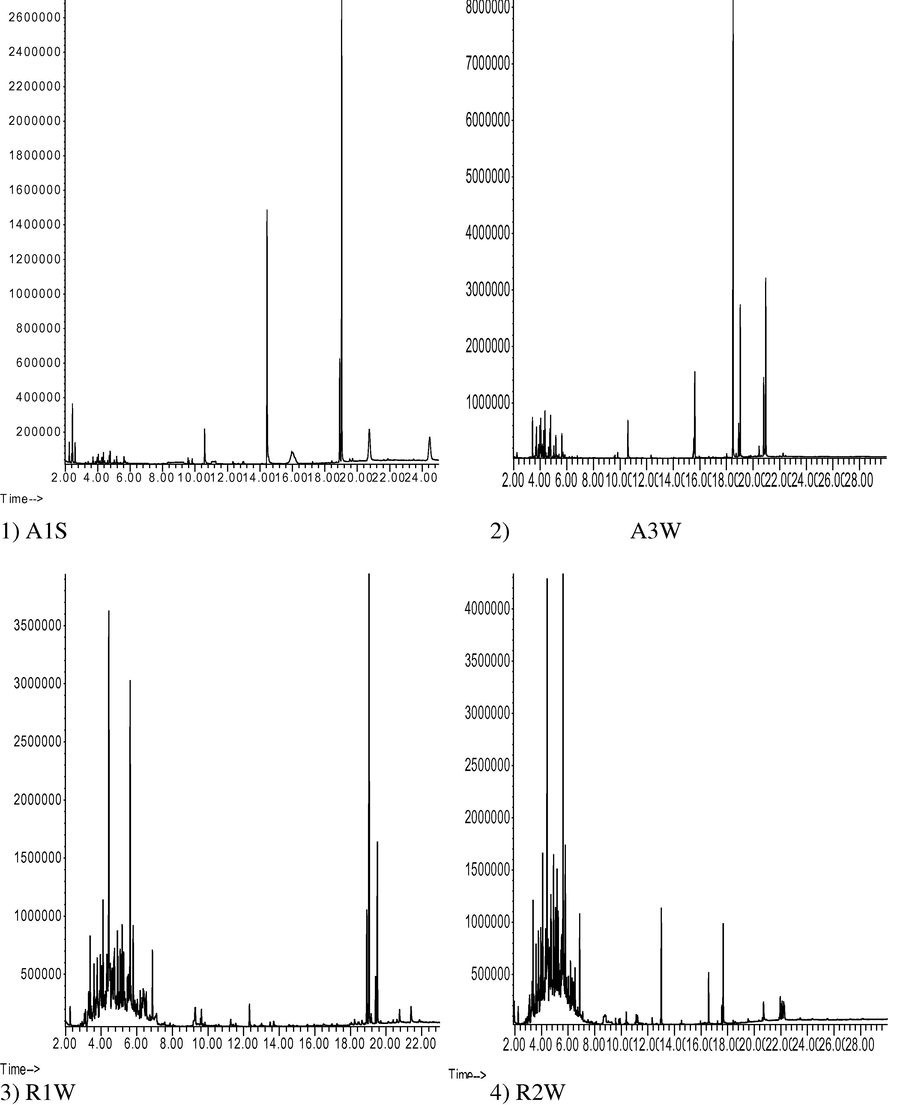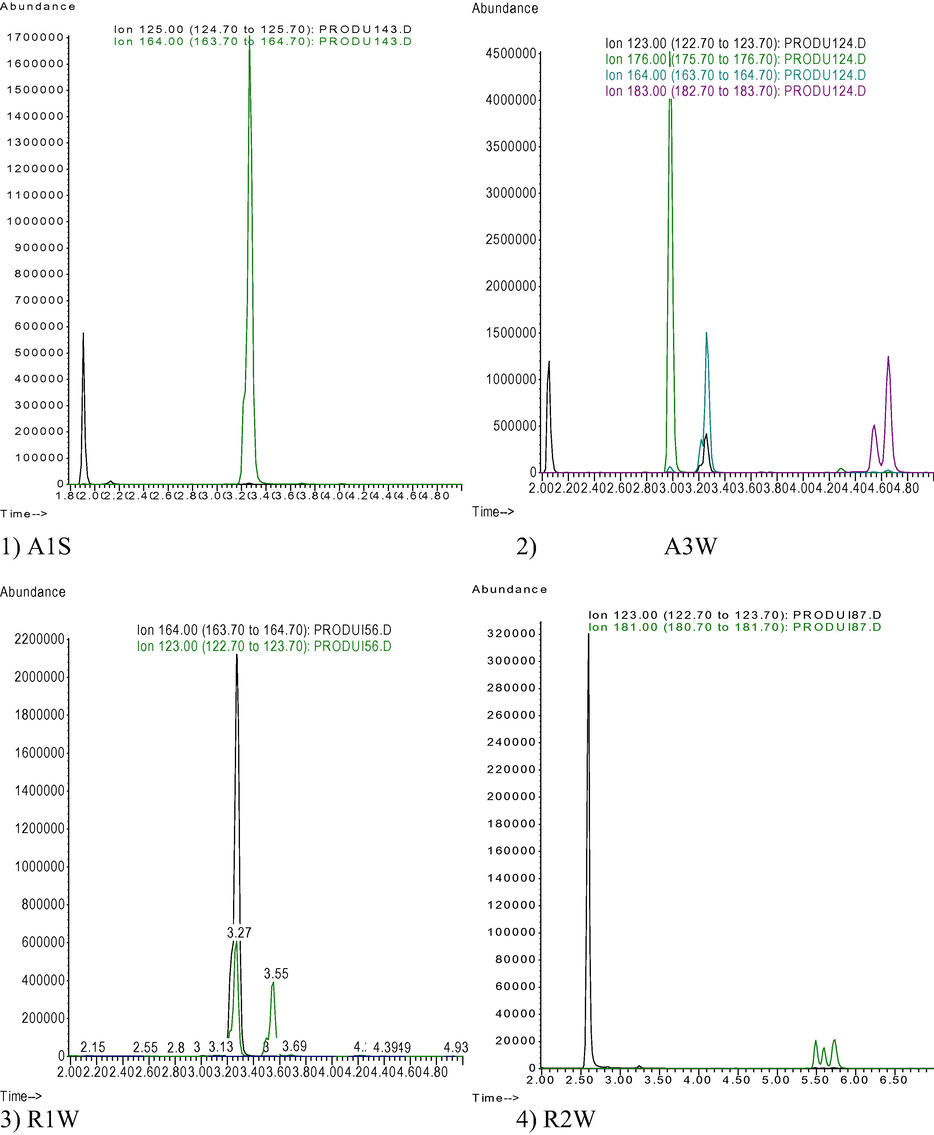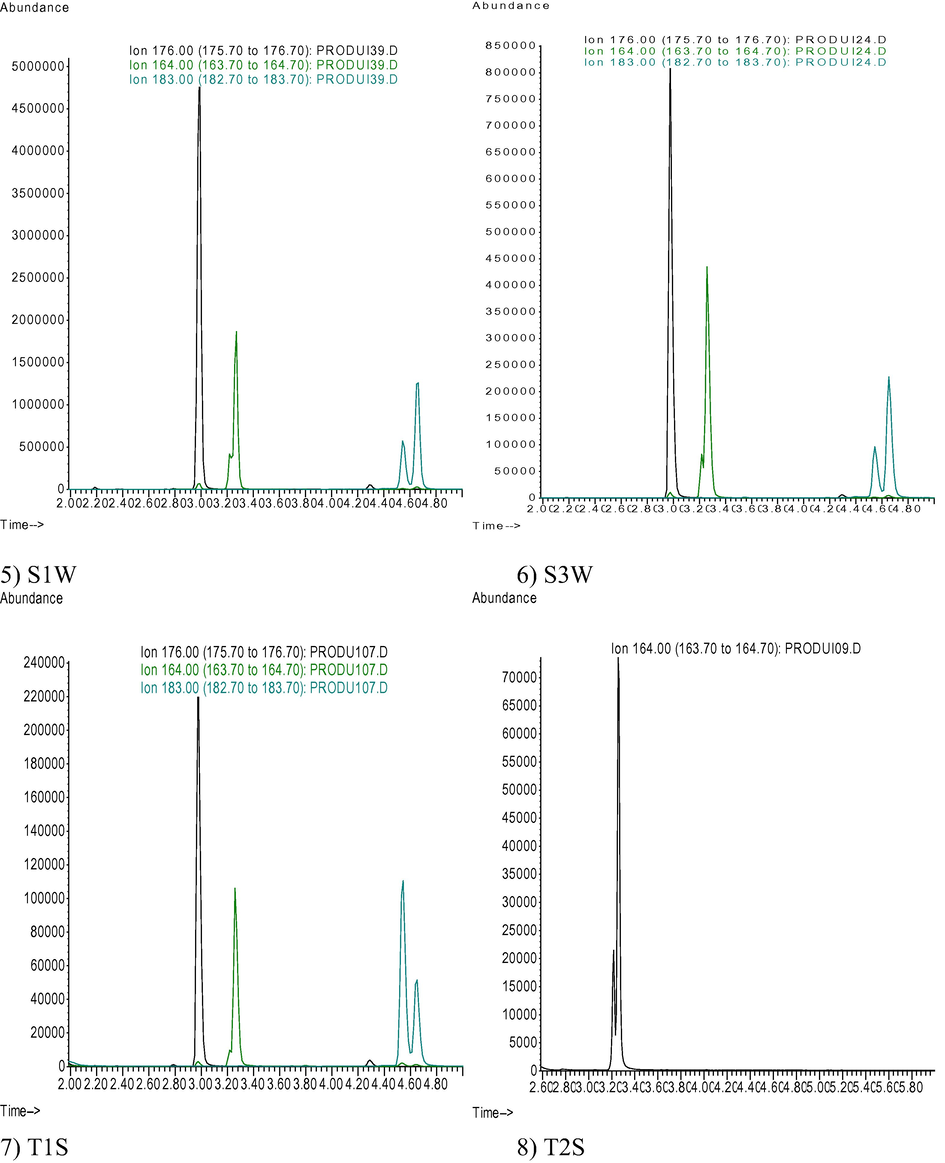Translate this page into:
Gas chromatography active ingredient control of aerosol insecticide from Algerian market
*Address: Laboratory of Functional Organic Analysis, Faculty of Chemistry, University of Sciences and Technology Houari Boumedienne, BP32, Bab-Ezzouar, Algiers, Algeria. Tel.: +213 551542478 safia7fr@yahoo.fr (Safia Zoubiri)
-
Received: ,
Accepted: ,
This article was originally published by Elsevier and was migrated to Scientific Scholar after the change of Publisher.
Available online 17 September 2010
Abstract
Household insecticide products are common and a popular mode of personal protection against household insect pests in all parts of the world. A chromatographic method for the control of aerosol insecticide active ingredient content was developed to be simple and rapid for the inspection of the numerous products for professional and private uses proposed in the Algerian market. Throughout, the most sold aerosol insecticides only two over eight were fair to the label declaration. However, the product labels need the addition of some details, like the active ingredients concentrations.
Keywords
Aerosol insecticide
Gas chromatography
Control
1 Introduction
Chemical pesticides have contributed greatly to the increase of yields in agriculture (Abhilash and Singh, 2009; Yusa et al., 2009). They come in various formulations, each of which is applied by using different techniques (Quackenbush et al., 2006). These products include, weed killers, aerosol fly sprays, pest strips, wood preservatives, shampoos to treat head lice, pesticides to treat problem insects such as cockroaches, rodenticides, and pesticides to treat fleas (Elflein et al., 2003). The National Household Pesticide Usage Study reported that 84% of homes used pesticides within the house, and 91% of households used pesticides in their home and garden (Grey et al., 2006). Insecticides protect buildings and other wooden structures from damage by termites and wood boring insects, thus decreasing maintenance costs and increasing longevity of buildings and their safety (Cooper and Dobson, 2007). They are also used to bring secondary benefits of improved health and fitness, reduced stress, and greater quality of life (Biehler, 2009).
Aerosols are the most convenient package that we use on an everyday basis. They are clean, portable, require no setup, and save time and money. The metal finishing industry uses aerosols to clean, degrease, dust off, prime, paint, undercoat, lubricate, etc (Johnson, 1982). The insecticide aerosols are the most widely used products and became a part of the people’s life for household use. One of their formulations is tetramethrin (0.20%), permethrin (0.10%), cypermethrin (0.03%), PBO (0.32%), fragrance (0.15%), Naptha (54.0%), purified LPG (45.20%) and propane-mixed butanes (73:27 V%) (Guomin et al., 2003).
The issue of pesticide is of particular importance as it has a significant negative impact (Atreya, 2008) on health and environment (Wilson and Tisdell, 2001). Due to the widespread use of these pesticides, extensive research has been undertaken to establish relevant environmental and toxicological profiles, including estimates of human exposure (Starr et al., 2008). Inappropriate application of pesticides affects the whole ecosystem (Abhilash and Singh, 2009). Highly inefficient practices include using inappropriate products, incorrect dosage (Zoubiri, 2010), timing and targeting of application, non-calibrated and poorly maintained or leaking application equipment (Williamson et al., 2008). Pesticide poisoning has been a concern since decades (Wesseling et al., 2005; Tariq et al., 2007). Children’s exposures to volatile pesticide vapors may be greater, being low to the ground, particularly those pesticides that have a density greater than air (Garry, 2004).
Non-occupational pesticides are widely available with a large range and high number of products, which are easy to purchase in everyday shops and are applied by amateur users in their homes and gardens (Lagaly, 2001). Pesticides are imperceptible to our senses and any potential harm from exposure is often rare and delayed (Grey et al., 2005). Pesticide products must by law have a label, which contains information about the product, hazard information, and instructions for use. A wide variety of products for professional and private use are available in the Algerian market. Therefore, the mean purpose of this study has been the use of fast chromatographic methods for the simultaneous determination of all active ingredients in aerosol insecticide samples for quality control of this type of product.
2 Experimental
2.1 Chemicals and solvents
The following chemicals were obtained from Dr. Ehrenstorfer GmbH, Augsburg, Germany: permethrin (94.0%), tetramethrin (99.0%), fenitrothion (97.7%) and cypermethrin (91.0%). Technical piperonyl butoxide (93.0%) and allethrin (90.0%) were sourced from Endura Spa, Italy. Acetone was of highest analytical grade available.
2.2 Aerosol insecticide products
The eight most used aerosol insecticide products in Algerian household were purchased from the Algerian market. The collected samples were codified: A1S, A3W, R1W, R2W S1W, S3W, T1S and T2S. The first letter refers to the product name, the second code character refers to the insect target (1. flying insects, 2. crawling insects, 3. both flying and crawling insects) and the third one designs the formulation type (S, solvent; W, aqueous). We announce in Table 1 the labeled chemical composition and the capacity of the studied codified aerosol insecticide.
Code
Active ingredient
Capacity (mL)
A1S
Tetramethrin 0.46%, fenitrothion 0.19%
400
A3W
Tetramethrin, permethrin, PBO
400
R1W
Tetramethrin 0.31%, diphenothrin 0.018%
300
R2W
Imiprothrin 0.1%, cypermethrin 0.1%
300
T1S
Tetramethrin, permethrin
400
T2S
Tetramethrin, permethrin
400
S1W
Non-specified
400
S3W
Tetramethrin 0.35%, permethrin 0.23%, PBO 0.46%
300
2.3 Analytical conditions
GC/MS was performed using a Hewlett Packard system (GC 6890; MSD 5973). Samples (1 μL) were introduced into the gas chromatograph injector held at 250 °C. The temperature program used was the following: 80–280 °C at 10 °C min−1, 280 °C for 5 min. Helium was used as carrier gas with a constant flow of 1 mL min−1. Mass spectrometric data were obtained under the following conditions: electron ionization, 70 eV; source temperature, 230 °C; transfer line, 280 °C. Mass spectra were first obtained in full scan mode (range of acquisition, 45–450 m/z) in order to define analytes retention time. The following quantifier ions (m/z) were monitored with SIM mode analysis: allethrin (123), fenitrothion (125), piperonyl butoxide (176), phenothrin (123, two peaks), imiprothrin (123, two peaks), tetramethrin (164, two peaks), permethrin (183, two peaks) and cypermethrin (163, four peaks) using the following temperature program: 260–280 °C at 10 °C min−1, 280 °C for 5 min.
2.4 Preparation methods
Product samples were prepared using WHO methodology (Chavasse and Yap, 1999). The individual pesticides standard stock solutions (10 mg mL−1) and standard mix solutions at 1 and 0.1 mg mL−1 were prepared in acetone and stored at 6 °C in the dark. Calibration samples were prepared at concentrations of 100, 200, 300, 400, 500, 600 and 700 μg mL−1.
3 Results and discussion
Fig. 1 presents the chromatograms obtained for the SCAN mode analysis of the eight chosen aerosol insecticides content. We have detected for some solvent aerosols (T1S and T2S) the use of non-treated oil, containing cyclic and aromatic hydrocarbons in the product formulations. However, A1S, A3W, S1W and S3W were aqueous spry formulations containing less solvent. The quantitative analysis (Table 2), lets us notice that some aerosols contain non-declared molecules like T1S which contains 0.03% of piperonyl butoxide and S3W with 0.18% allethrin. The same observation was made with A3W where four active ingredients were detected. However, permethrin which is a declared molecule in T2S product label was not detected. As we can notice, only three products are fair with their declaration (A1S, R1W and R2W). ND: Non-declared; DND: Declared but not detected.
Chromatograms obtained for the analysis of aerosol insecticides using SCAN mode.

Chromatograms obtained for the analysis of aerosol insecticides using SCAN mode.
Pesticide molecule
Concentrations by aerosol product (%)
WHO (%)
A1S
A3W
R1W
R2W
S1W
S3W
T1S
T2S
Allethrin
–
1.56ND
–
–
–
0.18ND
–
–
0.1–0.5b
Fenitrothion
0.85
–
–
–
–
–
–
–
5c
Piperonyl butoxide
–
3.00
–
–
0.44
0.70
0.03ND
–
–
Phenothrin
–
–
0.26a
–
–
–
–
–
0.05–1b
Imiprothrin
–
–
–
0.06a
–
–
–
–
–
Tetramethrin
0.77
1.14
0.36
–
0.18
0.46
0.02
0.02
0.03–0.6b
Permethrin
–
2.40
–
–
0.30
0.32
0.04
DND
0.05–1b; 2.5c
Cypermethrin
–
–
–
0.10
–
–
–
–
0.1–0.35b; 0.4–0.2c
Chromatograms for the SIM mode analysis were presented by Fig. 2. Quantitative results for both phenothrin and imiprothrin were obtained using allethrin–calibration curve. These three molecules were analysed using the same quantifier ion (m/z = 123) and the results shown were used only to have an idea about the possible phenothrin and imiprothrin concentrations.
Chromatograms obtained for the analysis of aerosol insecticides using SIM mode. Allethrin (123 at 2.06 min), fenitrothion (125 at 2.62 min), piperonyl butoxide (176 at 2.98 min), phenothrin (123, two peaks at 3.23 and 3.27 min), imiprothrin (123, two peaks at 3.50 and 3.55 min), tetramethrin (164, two peaks at 3.26 and 3.30 min), permethrin (183, two peaks at 4.55 and 4.66 min) and cypermethrin (163, four peaks at 5.54, 5.64, 5.78 and 5.85 min).

Chromatograms obtained for the analysis of aerosol insecticides using SIM mode. Allethrin (123 at 2.06 min), fenitrothion (125 at 2.62 min), piperonyl butoxide (176 at 2.98 min), phenothrin (123, two peaks at 3.23 and 3.27 min), imiprothrin (123, two peaks at 3.50 and 3.55 min), tetramethrin (164, two peaks at 3.26 and 3.30 min), permethrin (183, two peaks at 4.55 and 4.66 min) and cypermethrin (163, four peaks at 5.54, 5.64, 5.78 and 5.85 min).
The obtained results showed that some products active ingredients concentrations (A1S, A3W), were greater than the ones declared by the OMS organisation (Chavasse and Yap, 1999). The aerosol product code T2S, uses in its formulation only tetramethrin at a low concentration when compared to WHO concentrations. Nevertheless, this product has good insecticide effect with reference to some consumer declarations. These remarks were made with the R2W product too. The use of four active ingredients may be one of the reasons of the efficacy of the A3W and S3W products. However, these products should be applied reasonably.
4 Conclusion
Production and uses of pesticides are still increasing but must be strongly controlled to minimize the health and environmental problems. It is more economical to reduce the applied amounts of pesticides than to decompose the non-bioactive amounts if ever possible (Lagaly, 2001). The aerosol insecticides selected for the present study could be controlled by GC–MS; the method was simple and rapid. Application of this technique showed its ability in controlling the real aerosol content. Throughout the eight aerosol insecticide simple products, we can make the following comments:
-
–
High active ingredient concentration (two products).
-
–
Presence of non-declared active ingredient molecules (two products).
-
–
Absence of declared active ingredient molecules (two products).
-
–
No information about the active ingredient molecules identities (one product).
-
–
No information about the active ingredient molecules concentrations (three products).
Finally, we can say that only two products are fair toward the label declaration. Their manufacturers offered to the consumer two efficient products using the lowest active ingredient concentration.
References
- Pesticide use and application: an Indian scenario. J. Hazard. Mater.. 2009;165:1-12.
- [Google Scholar]
- Health costs from short-term exposure to pesticides in Nepal. Soc. Sci. Med.. 2008;67:511-519.
- [Google Scholar]
- Permeable homes: a historical political ecology of insects and pesticides in US public housing. Geoforum. 2009;40:1014-1023.
- [Google Scholar]
- Chavasse, D.C., Yap, H.H., 1999. Chemical methods for the control of vectors and pests of public health importance, WHO CTC. WHO PES 79.2, <http://whqlibdoc.who.int/hq/1997/WHO_CTD_WHOPES_97.2.pdf/>.
- The benefits of pesticides to mankind and the environment. Crop Prot.. 2007;26:1337-1348.
- [Google Scholar]
- Development of a gas chromatography–mass spectrometry method for the determination of household insecticides in indoor air. J. Chromatogr. A. 2003;985:147-157.
- [Google Scholar]
- Use and storage of domestic pesticides in the UK. Sci. Total Environ.. 2006;368:465-470.
- [Google Scholar]
- The Handbook of Insecticide Formulations and its Technologies for Household and Public Health Uses. Hong Kong: Cosmos book Ltd.; 2003.
- The Aerosol Handbook (second ed.). Mendhull: Wayne Dorlantl Co.; 1982.
- Appl. Clay Sci.. 2001;18:205-209.
- Screening for pesticide exposure: a case study. J. Midwifery Womens Health. 2006;51(1):3-10.
- [Google Scholar]
- Pyrethroid pesticides and their metabolites in vacuum cleaner dust collected from homes and day-care centers. Environ. Res.. 2008;108:271-279.
- [Google Scholar]
- Acute pesticide poisoning and pesticide registration in Central America. Toxicol. Appl. Pharmacol.. 2005;207:S697-S705.
- [Google Scholar]
- Trends in pesticide use and drivers for safer pest management in four African countries. Crop Prot.. 2008;27:1327-1334.
- [Google Scholar]
- Why farmers continue to use pesticides despite environmental, health and sustainability costs. Ecol. Econ.. 2001;39:449-462.
- [Google Scholar]
- Sampling and analysis of pesticides in ambient air. J. Chromatogr. A. 2009;1216:2972-2983.
- [Google Scholar]
- Zoubiri S., 2010. Chemical characteristics of aerosol insecticide deposition in indoor surfaces. Arabian J. Chem. doi:10.1016/j.arabjc.2010.06.030.







